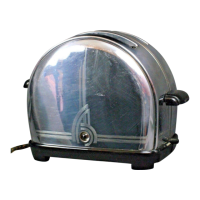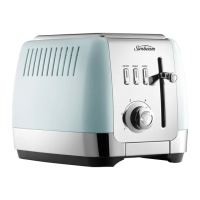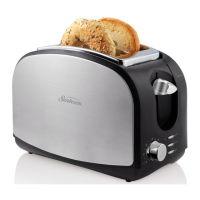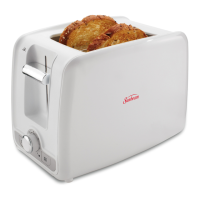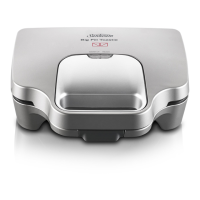-
13
-
5 . Bread Rises Too Slowly
(a) This complaint may be due to the impatience of the user. Actually the toasting
cycle from a cold start takes less time than any toaster previously
manufactured. The toasting cycle will vary with voltage changes, dryness of
bread, or if toaster is cold or warm. Under normal conditions (Which means
testing with moderately fresh bread on 115 Volts A.C. with Toaster set at
Medium) the total toasting cycle will vary from
1-1/2
minutes when starting with
a cold Toaster
to
less than 1 minute
as
the Toaster warms up. When properly
adjusted,
it will lower or raise the bread in approximately 9 seconds
(b) If Toaster is
out
of adjustment and takes 8
to
12 seconds
to
raise the bread,
observe motion of Bread Lifter Assembly. The Bread Lifter Assembly should move
up
and down smoothly without excessive jerking. Check
to see
that Bread Lifter
Assembly moves free of frame and
adjust by
bending, if necessary. If Bread
Lifter Assembly is free, then slightly turn the screw on the bottom of the
Center Element
(10)
counter-clockwise. This will increase the stress on the wire
of the Center Element causing its contraction
to
effect Bread Lifter Assembly
motion sooner. Do not make this adjustment unless absolutely necessary, and then
make only slight adjustment
so as
not
to put to
much stress on wire of Center
Element
.
Always
test
Toaster first under normal conditions
,
to
determine if
customer'
s
complaint is justifiable and warrants an adjustment of this assembly.
6.
Toast Not of Uniform Color
-
The individual elements are measured for resistance,
graded and matched
at
the factory,
so as to
obtain substantially uniform toasting on
all
of the four faces comprising the two slices of bread in the Toaster
at
any one
time.
It is clear that all four of these surfaces should
be
of uniform dryness. The
Center Element has associated with itself slightly more heat
capacity
than
the end
elements,
so
that when Toaster is cold, the inside surfaces (those facing
Center
Element) will come
out
slightly lighter than other two
surfaces.
However, with
perfectly
matched elements and
uniform
condition of bread
surface dryness, there
should be
no great
difference
in color
as
Toaster
heats up.
Because of all
the
variable factors, in addition
to the
two
mentioned, do
not assume
that the
elements
are mismatched unless
several
sets
of
toast
are made and judgment
passed
on
the
average result.
If after such
test,
the
inside surfaces consistently toast lighter
or
darker
than
outside surfaces, replace
with
a set
of
matched
elements,
but
only on
authorization
by
customer.
7.
Single Slice Toasting
-
The two
chambers are adequately baffled from each other so
as to permit toasting of a single slice if desired.
However
if
several
single slices
are toasted in a
row,
the empty slot becomes so hot that it cannot but unavoidably
affect the other slot. As a result, the bread surface facing the Center Element
will
come out darker.
8. Outside Surfaces Have Dark Vertical Streaks
-
The end elements are
wound
